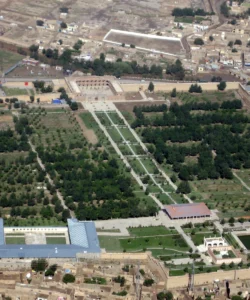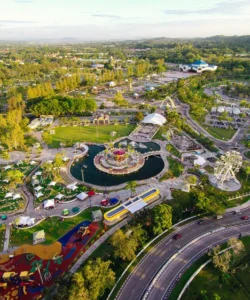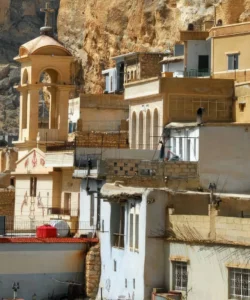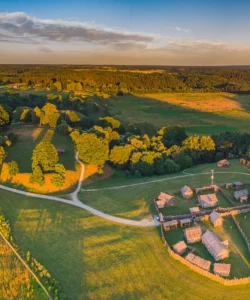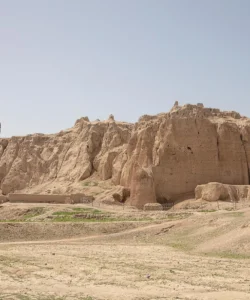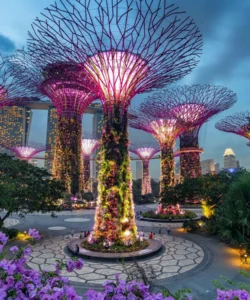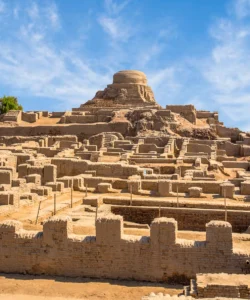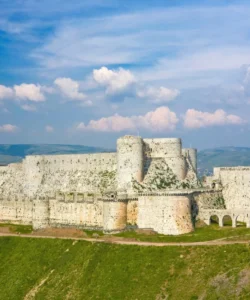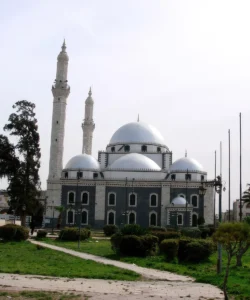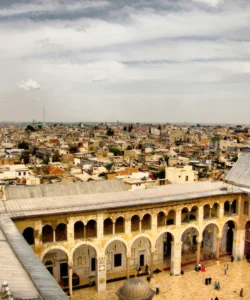Krak des Chevaliers, also known as Qal’at al-Hisn, is a massive Crusader castle in Syria and one of the most important and well-preserved examples of medieval military architecture in the world. Originally built to guard a strategic route, it became an almost impregnable stronghold of the Knights Hospitaller during the Crusades.
Listen to an introduction about Krak des Chevaliers
Name and Address
Name: Krak des Chevaliers (Arabic: حصن الأكراد, Hisn al-Akrad or قلعة الحصن, Qal’at al-Hisn) which translates to “Castle of the Knights” or “Fortress of the Kurds.”
Address: The castle is located in the Homs Gap, a strategically vital route between the city of Homs and the Mediterranean coast. It is situated near the village of Al-Hisn in the Homs Governorate of Syria, close to the border with Lebanon.
How to Get There
A note on travel: Due to the ongoing civil war and a volatile security situation, most governments advise against all travel to Syria. It is crucial to consult up-to-date travel advisories from your home country before considering any travel to the region.
Assuming safe travel is possible, here is how you would typically get there:
- From Homs: Krak des Chevaliers is a short drive, approximately 50 kilometers, from the city of Homs. You would need to travel by car or private taxi.
- From Damascus: The castle is a popular day trip from Damascus, located about 100 kilometers to the north. A private car or an organized tour would be the primary mode of transport.
Landscape and Architecture
Krak des Chevaliers is a masterpiece of concentric castle design, built on a hilltop to maximize its defensive capabilities.
- Concentric Walls: The fortress is a classic example of a concentric castle, featuring two sets of massive stone walls separated by a wide moat. This layered defense system meant that if one wall was breached, the inner wall still provided protection.
- Imposing Towers: The walls are flanked by numerous round and square towers at regular intervals, providing overlapping fields of fire and making a direct assault extremely difficult.
- Location and Design: The castle is built on a natural citadel with steep slopes on three sides, providing a perfect defensive position. Its designers took full advantage of the terrain to create an almost impregnable fortress.
- Gothic and Mamluk Elements: The architecture is primarily Romanesque and Gothic in style, built by the Crusaders. However, after its capture by the Mamluk Sultan Baibars in 1271, new features were added, including a massive square tower and a mosque, which incorporated elements of Mamluk architecture.
What Makes It Famous
Krak des Chevaliers is famous for its exceptional preservation and its legendary role in medieval history.
- “The Most Beautiful Castle in the World”: T.E. Lawrence, of Lawrence of Arabia fame, famously described it as “perhaps the best preserved and most wholly admirable castle in the world.”
- A Crusader Stronghold: It was the largest and most important Crusader castle in the Middle East, a symbol of Christian military power and a key bulwark against Muslim expansion for over a century.
- Strategic Importance: The castle’s location allowed it to control the Homs Gap, a vital pass between the coast and the inland plains of Syria, making it a critical military and administrative center.
- Withstanding Sieges: Krak des Chevaliers was considered virtually impregnable. It withstood multiple sieges, including an attack by the legendary Muslim leader Saladin, before finally falling to the Mamluks through a strategic deception rather than military force.
Differences from Some Other Wonders (e.g., The Citadel of Aleppo)
While both Krak des Chevaliers and the Citadel of Aleppo are medieval military fortresses in Syria, they have some key differences.
- Historical Owners: Krak des Chevaliers is primarily known as a Crusader stronghold, built and fortified by the Knights Hospitaller. The Citadel of Aleppo, while also used by Crusaders, is more famously associated with the Ayyubid and Mamluk dynasties, who made extensive additions to its structure.
- Location and Function: Krak des Chevaliers was a rural, isolated fortress that controlled a key pass. The Citadel of Aleppo was an urban fortress, the central point of a major city and a symbol of civic power.
- Scale and Preservation: Krak des Chevaliers is considered one of the most complete and best-preserved medieval castles in existence. The Citadel of Aleppo is also a magnificent structure, but the city around it was heavily damaged during the recent conflict.
Krak des Chevaliers Photos:































